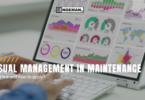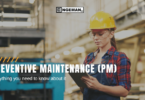With today’s increasingly competitive market, the relation between maintenance processes and Return on Investment has been constantly discussed. After all, it is necessary to develop practices that make this service increasingly effective, so that the money invested by the company is rewarded.
However, it is common for doubts to arise when verifying the validity of these numbers. With that in mind, we have created this post to definitively clarify everything you need to know about the maintenance management ROI and how to verify it. Check it out!
What is ROI?
Every money that is applied in a company to have a future return is called Investment. Because it is a monetary factor, investments must be made with strategy, studies and a lot of planning. After all, which company will spend its capital on something that does not know if it will bring results to its business? Impossible!
This way, knowing how to invest is as important as knowing what return it will bring to the company. In this sense, the metric used to calculate this return is the ROI. Return Over Investment (ROI) is a metric widely used by organizations to have a basis for measuring, through the evaluation of revenue, costs and investments, their expenses and investments.
How to calculate the ROI?
To calculate the ROI, the following formula is used:

Where:
- Revenue: it is all the amount that enters the company. Remember that if ROI is being calculated for a particular industry, only the revenue for a particular industry should be used and not for the company as a whole. It is possible to calculate the ROI of the marketing, HR, IT, maintenance sector, for example.
- Cost: it is all the value that is used to enable the investment, that is, the expenses. In the same way as revenue, costs should be considered according to the sector that the ROI is being analyzed.
After the calculations, the managers will analyze according to the company area. Even in different sectors and branches, the way to analyze these results is very similar. If the result is positive, it means that the company made profits. If the result is negative, it indicates that the company had a loss, that is, the costs are higher than the revenue, and therefore not a positive result.
The importance of maintenance
Maintenance is a procedure that must be handled with extreme attention by the company. In short, one cannot simply deploy it and expect the investment to be worthwhile.
Even small companies rely on machinery of high importance for the production processes, and, moreover, such equipment is not cheap. It is up to the maintenance to keep everything working properly and reduce the risks of unexpected breaks and, consequently, delays in production.
In times of crisis, for example, expectations regarding maintenance performance grow even more, since there is a decrease in investments in equipment renovation.
Another important issue is how to identify the hidden costs that exist in the management of this process. After all, it is necessary to consider the amount invested in personnel, material and even in outsourced services, when the need arises.
The maintenance management ROI
Recognition of the importance of maintenance within companies led to engineering techniques being developed and applied as models for the management of this sector. Thus, good management practices can make the difference in the application of each service.
You don’t have to be a subject matter expert to know that the more corrective maintenance a company performs, the higher the final cost for production. Therefore, two of the processes that should receive special attention are those of predictive and preventive maintenance.
Efficient management is one that raises enough information to establish predictive maintenance processes at the right time. This involves, for example, the creation of documents for individual machine monitoring. They must contain a maintenance checklist of each type, a schedule for replacement of parts and who is the person responsible for these tasks.
In addition, periodic analysis are required to plan ways to improve maintenance processes. Keeping machines running uninterrupted should be the overall purpose of management.
CAC and ROI: how to optimize them
Customer Acquisition Cost (CAC) is a metric used to measure the value of a new customer to the company. Thus, it is possible to know the profit generated by this customer, the service life and also which are the viable channels of acquisition of this customer. To calculate the CAC, you must divide the total amount of investments that your company has had to attract new customers by the number of new customers in a specified period.
The CAC plays an important role as the basis of calculation for the maintenance management ROI. Its value is given by the investment in acquiring new customers. It is an essential tool to assess whether a company’s action strategies are actually working.
Applying management that optimizes CAC and ROI is something that involves planning and assertive decisions. A good way to start is to estimate the expected expenses for the next month and compare them to the actual expenses. It is important to constantly update this data to get a sense of the immediate return on this investment.
It is also necessary to apply an external reference so that these values do not exceed the market average. This value sets the maintenance investment benchmark.
An optimized CAC is one that shows an amount invested in equipment and labor for maintenance lower than its Return on Investment.
How to submit the ROI?
In order to effectively verify the ROI, it is necessary to have certain information related to the maintenance management processes. This means that it is essential to have a tool, such as specialized software, that enables the survey. Then, for example, make a survey and thus compare the expenses between CAC and ROI over the months.
We can classify these amounts into direct costs, loss costs, and indirect costs. The first ones refer to the investment required to keep equipment running, such as predictive maintenance, revisions, etc. The loss cost encompasses problems that have caused the equipment to stop. The indirect ones are investments with management, administration, studies for improvements and other activities of the sort.
Optimizing the maintenance process
Once the values for each of these items are identified, it will be possible to invest in actions that place the ROI, at least, within the forecast. Over time, it is possible to increase the profit margin gradually.
It is essential to emphasize that the lack of efficient management results not only in equipment stoppage at critical times, but also increases inventory expenses.
It is no wonder that this is one of the causes of difficulty in the growth of some companies. The lack of efficient management prevents a proven ROI in maintenance and reflects negatively on the final profit.
With good planning, it is possible to achieve optimal results for the maintenance management ROI.
After all, why is ROI important?
Investments in any sector within a company must be based on concrete and correct data about the benefits that they will bring. Investments are made in a way that brings more profitability to organizations. With the proper calculation of the ROI, it is possible to draw data-based goals and monitor more effectively all of your investments.
Companies that properly use ROI can draw more attention from investors as well, as it is an important indicator to understand the profitability of their business.
In addition to providing security in the decisions that will be made in the company, it also allows assessing which investments should be maintained by the company, as unnecessary expenses will not bring profits to the company.
ROI using Engeman®
Engeman® provides an excellent Return on Investment by improving production quality. The companies rely on high importance machinery for the production processes and it is up to the maintenance to keep everything working properly and reduce the risks of unexpected breaks and, consequently, delays in production.
With the adoption of a maintenance system, the entire management of the company improves, as it provides efficiency in processes, increased productivity and optimization of maintenance costs.
We help our customers to calculate the cost reduction potential that can be achieved in the company through the adoption of techniques focused on maintenance engineering concepts through our tool.
Be sure to count on the best technology for those who seek to optimize the Return on Investment. Log in now and get to know Engeman®!








